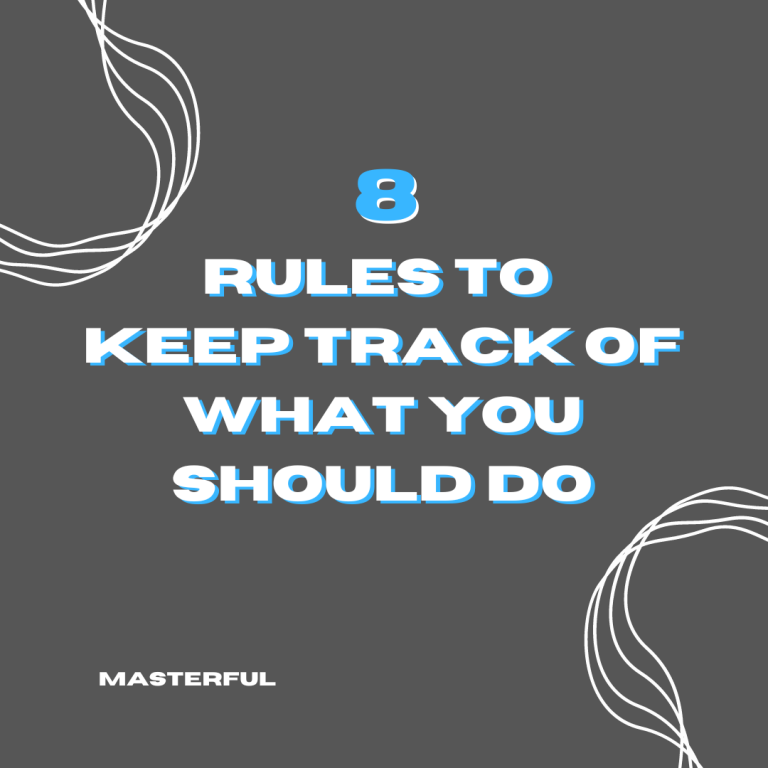We have a lot on our minds, where our personal and professional tasks often overlap, creating a jumble of responsibilities that can be challenging to manage. This can lead to stress, missed deadlines, and a pervasive feeling of being overwhelmed.
In this article I will show you 8 essential rules to keep track of what you need to do. This will answer your question How do you keep track of what you have to do. And will make you better organized, more productive and less stressed!
Let’s start with rule number one…
1. Make an Inbox for Things That Need to Be Done
Keeping track of your tasks is essential for productivity, and creating an “inbox” for your to-do’s is a great way to start.
Think of an inbox as a repository for tasks, similar to the way your email inbox serves as a holding area for incoming messages. There are two main types of inboxes you might consider: a digital inbox and a physical inbox. Each has its unique benefits and applications.
Digital Inbox
A digital inbox is ideal for managing tasks, meetings, and commitments. Numerous applications, such as Todoist or ClickUp, serve this purpose, providing a single, organized space where you can compile your tasks. Whenever a new duty arises, add it to your digital inbox to be addressed when you have the time.
Physical Inbox
On the other hand, a physical inbox, which could be a stylish pot or a handy organizer, is primarily for documents or tangible items that need attention. This concept harkens back to the days of a literal in-basket on your desk, waiting for papers requiring your review.
The beauty of these inboxes is their flexibility. You can have separate inboxes at work and at home, enabling you to compartmentalize your tasks and streamline your productivity.
2. Write down all the details
We often resort to jotting down tasks in half sentences or cryptic shorthand. While this might seem efficient in the heat of the moment, it often leads to confusion or forgetfulness when we return to the task later. A key rule to effective task management is to write down all the details.
When adding a task to your inbox, think of it as writing a brief to your future self. This brief should include all the information necessary to complete the task without the need to dredge through your memory or search for missing pieces of information. Here are a few tips to consider:
Be Specific
Avoid vagueness. Instead of noting down “Prepare report,” specify it further: “Prepare Q2 sales report for the marketing team.” The clarity will save you time and mental energy when you revisit the task.
Include Relevant Information
If your task involves other people, dates, or resources, make sure to note these down. For instance, “Email John the design proposal (stored in Drive > Projects > 2023 > Designs) by June 20.”
3. Organize your things
Once you have your inboxes filled with clearly defined tasks, the next essential rule is to organize your things. This step involves categorizing your tasks based on the type of action required and the sphere of life they belong to.
Proper organization offers a clear overview of your obligations, helps prioritize effectively, and ultimately fosters productivity. Below, we’ll discuss two important dimensions of task organization.
Action-Based Categorization
There are five common categories based on the type of action required:
- Action to Do: These are tasks that you need to act upon directly. They could be as simple as grocery shopping or as complex as drafting a business proposal.
- Calendar: These are tasks or commitments scheduled for a specific date or time. Examples include meetings, doctor’s appointments, and deadlines.
- Delegated: These are tasks you’ve assigned to others, but still need to track. It could be a report your colleague is preparing or a chore your child is tasked with.
- Maybe Someday: These are tasks or projects you’d like to do, but they’re not urgent or directly tied to your current goals. It could be learning a new language or planning a vacation.
- Documents to Archive: These are documents that you don’t need presently but might need in the future. Examples include tax returns, receipts, or reference materials for a project.
Sphere-of-Life Categorization
Your tasks can also be categorized based on different areas or ‘spheres’ of your life:
- Home: Tasks related to your household, family, or personal hobbies.
- Work: Tasks associated with your profession or career.
- (You might have additional categories depending on your lifestyle, such as ‘School,’ ‘Side Business,’ or ‘Volunteer Work’.)
This classification helps to create a balanced overview of your tasks, preventing one area of your life from dominating your attention and time.
4. Create a document archive
Our professional and personal lives generate a vast array of documents that are important but not immediately necessary. It can be frustrating, and sometimes detrimental, when such a document is needed but can’t be located. The fourth rule for effective task management is to create a document archive.
A document archive is a designated place, either physical or digital, where you store all your valuable documents for future reference. However, an archive is only as good as its organization. A well-structured archive system should allow you to retrieve any document within a minute. Here’s how to achieve that:
Develop a Logical Structure
Create a structure that makes sense for your situation. You could categorize by document type (e.g., tax documents, educational certificates), by date (e.g., 2022 Tax Returns), or by project (e.g., Home Renovation 2023).
Maintain Consistency
Once you’ve chosen a system, stick with it. Consistency ensures that you always know where to file new documents and where to find old ones.
Use Clear and Descriptive Labels
Label your files or folders in a manner that clearly describes their contents. Avoid abbreviations or codes that you might forget later.
Regularly Update and Prune
Periodically review your archive to keep it up-to-date. Discard or shred documents that are no longer needed, and update files as new documents come in.
Ensure Easy Accessibility
Choose an accessible location for your archive. If it’s a physical archive, it could be a dedicated drawer in your office. If it’s digital, consider a cloud-based service like Google Drive or Dropbox, which can be accessed from any device.
5. Clarify action
The fifth rule to keep track of what you need to do is to clarify action. This principle involves breaking down your tasks into actionable steps, anticipating the resources required, and estimating the time each task will take.
Understanding the actions necessary for each task provides clarity, promotes productivity, and eliminates the paralysis that can come from facing a seemingly mammoth task. Here’s how to clarify action for your tasks:
Break Down Tasks
Many tasks are actually multi-step projects in disguise. For example, “Prepare quarterly financial report” might involve collecting data, analyzing it, and finally, drafting the report document. Breaking down tasks into smaller, manageable steps makes them less intimidating and more approachable.
Assign Time Estimates
For each task or sub-task, estimate how much time you think it will take to complete. This allows you to plan your schedule more accurately. It also helps you to identify tasks that can be done in small pockets of time (“5-minute tasks”) versus those that require longer, uninterrupted focus.
Identify Required Resources
Note down what tools or resources you’ll need to complete the task. Does it require a computer? Can it be done via phone while you’re on the move? Or perhaps, it needs to be done at the office where you have access to specific documents or equipment.
Use Tags
Tags can be a powerful tool for organizing your tasks. You could use tags to indicate estimated time (e.g., “5-minute task”, “1-hour task”), required resources (e.g., “Phone”, “Office”), or even energy levels (e.g., “High Energy”, “Low Energy”).
6. Don’t prioritize things
It might seem counterintuitive, but the sixth rule states: Don’t prioritize things. While prioritization is typically seen as crucial in task management, it can sometimes lead to an overwhelming sense that every task is equally important, making it challenging to discern what to tackle first.
What’s more, over-prioritizing can result in us becoming slaves to our to-do list, leaving us feeling frazzled and guilty about any uncompleted tasks. So, instead of trying to prioritize everything, consider this alternative approach:
Create a “Maybe” Category
This category is for tasks you’d like to do, but they aren’t urgent or critical to your immediate goals. By giving yourself permission to set these tasks aside for now, you free up mental space and time to focus on tasks that genuinely require your immediate attention. These could include tasks like “Start learning Spanish” or “Redesign the guest room”.
It’s important to review this “Maybe” category periodically. When you find yourself with extra time or need a break from your routine tasks, you can dip into this list for a refreshing change of pace.
Shift from Importance to Urgency
Instead of ranking tasks based on their importance, consider their urgency. Which tasks have a deadline approaching? Which tasks have consequences if they’re not completed soon? This shift can make it easier to decide what to work on next.
7. Reviews your lists
The seventh rule to maintain control over your tasks is to review your lists. Even the most meticulously compiled and organized to-do list can become overwhelming or outdated if not regularly reviewed.
Reviewing your lists ensures they remain relevant, enables you to track progress, and helps reassess your priorities. It also prevents tasks from slipping through the cracks and promotes a sense of accomplishment as you witness tasks being completed. Here’s how to go about it:
Daily Review
At the end of each day, take a few minutes to review your list. Mark off completed tasks, and assess whether any tasks need to be shifted to a different category or timeframe based on your accomplishments and any new tasks that have arisen.
Weekly Review
Once a week, set aside time for a more comprehensive review. This session should include:
- Cleaning Up: Remove completed tasks and delete or archive tasks that are no longer relevant.
- Assessing Progress: Review your tasks and note any progress made. This not only gives a sense of accomplishment but also helps identify any bottlenecks or recurring issues.
- Re-evaluating Priorities: Consider the urgency and importance of your remaining tasks. Adjust their statuses or categories as needed.
- Planning Ahead: Based on your reviewed list, plan for the coming week. Allocate time for tasks and ensure that your workload is realistic and manageable.
Regular reviews keep your task management system functional and efficient. They provide a clear picture of what needs your attention, which tasks are progressing, and which ones might need to be reconsidered. By incorporating regular reviews into your routine, you ensure that your system stays fresh, relevant, and effective.
8. Engage
The final rule in keeping track of what you need to do is simply to engage. After diligently following the previous steps—making an inbox for things to be done, writing down all the details, organizing your tasks, creating a document archive, clarifying actions, rethinking prioritization, and regularly reviewing your lists—you are now ready to take action!
With everything outlined and organized, it’s significantly easier to determine what to tackle next. Here are a few points to remember as you dive into execution:
Just Start
Often, starting is the hardest part. Once you begin a task, momentum builds and it becomes easier to continue. Don’t overthink it—just start!
Monitor Passive Tasks
Some tasks won’t require your direct action but will still need your attention. This includes tasks you’re waiting on, like a response from a colleague, or tasks you’ve delegated. Keep these tasks on your list with a note to track their progress.
Tackle Small Tasks Immediately
If a task is small and quick (often referred to as “two-minute tasks”), it might be more efficient to complete it immediately rather than going through the process of cataloging and reviewing it. This keeps your list cleaner and gives you an immediate sense of accomplishment.
Taking the step from planning to action can feel daunting, but remember, the perfect moment to start will never come. The best time to engage with your tasks is now. With everything in its place, you have the tools you need to approach your tasks with confidence, knowing that nothing will slip through the cracks. Stay organized, stay engaged, and watch your productivity soar.




